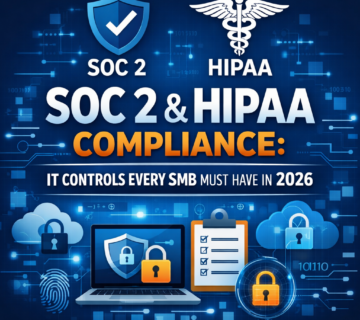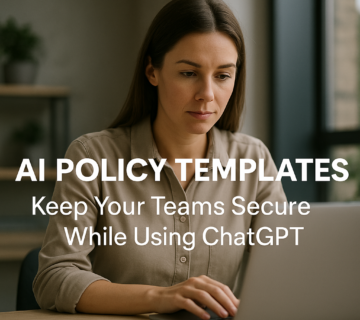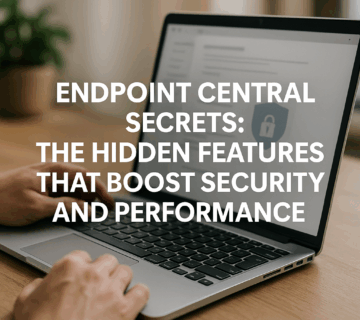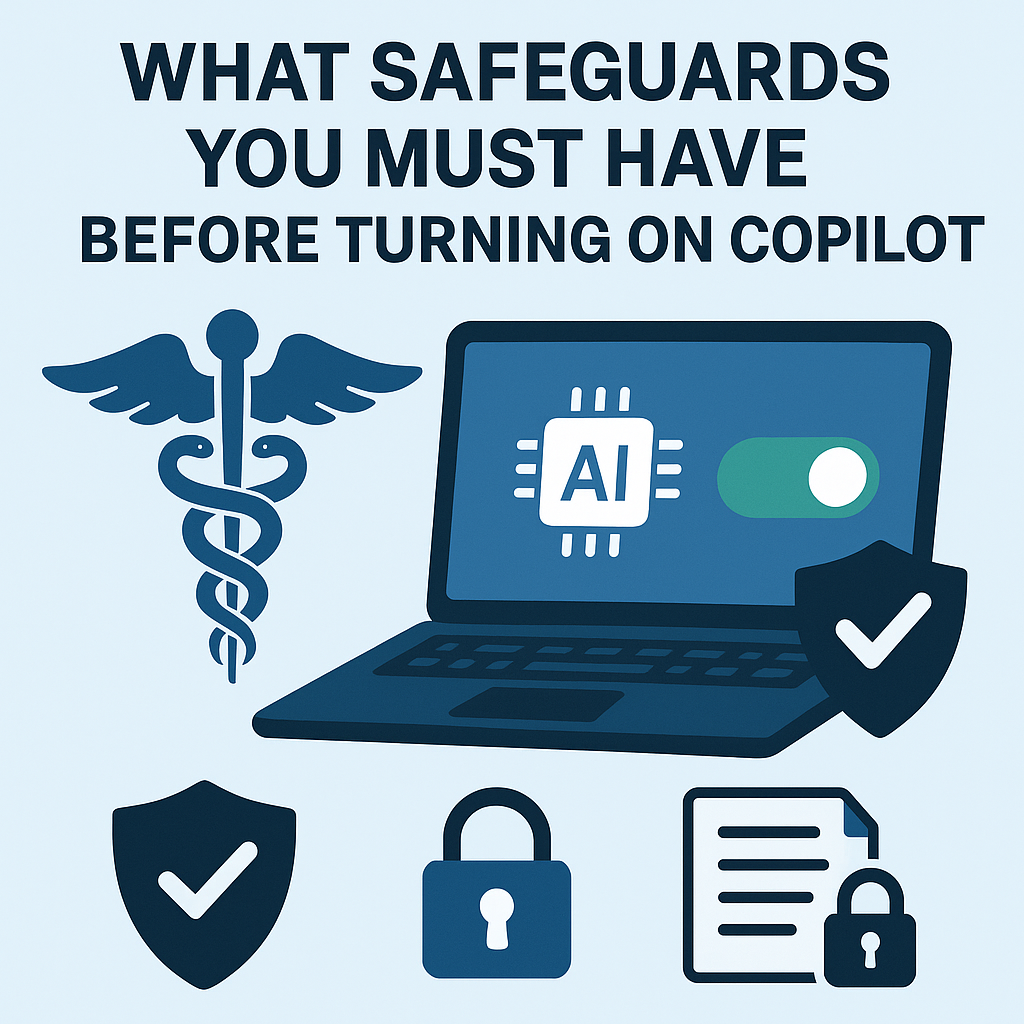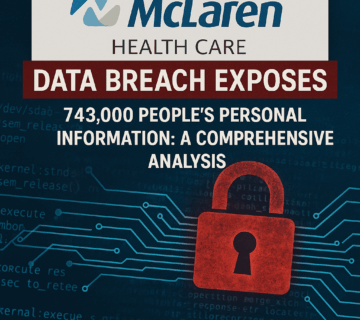SOC 2 Compliance with AI: How to Collect Evidence Automatically Without Breaking Rules
🎙️ Dive Deeper with Our Podcast!
AI-Powered SOC 2 Compliance Automation
👉 Listen to the Episode: https://technijian.com/podcast/ai-powered-soc-2-compliance-automation/
Subscribe: Youtube | Spotify | Amazon
Introduction: The Compliance Burden Every Growing Business Feels
If you’re responsible for SOC 2 compliance, you know the pain all too well. Every audit cycle brings the same exhausting routine—scrambling through multiple systems to gather evidence, manually documenting controls, creating endless screenshots, and praying you haven’t missed a critical piece of documentation that could derail your entire audit.
The stakes couldn’t be higher. SOC 2 certification opens doors to enterprise clients, builds trust with security-conscious customers, and demonstrates your commitment to protecting sensitive data. But the traditional approach to compliance evidence collection consumes hundreds of hours, pulls your technical team away from innovation, and introduces human error at every turn.
What if compliance evidence collected itself automatically, continuously, and correctly?
The answer lies in AI-powered compliance automation that doesn’t just make evidence collection easier—it makes it more accurate, more complete, and more defensible. This isn’t about cutting corners or gaming the system. It’s about using intelligent technology to document your security controls properly while freeing your team to focus on actually improving security rather than just documenting it.
Why Manual SOC 2 Evidence Collection Is Failing Your Organization
Before exploring the solution, let’s acknowledge why the traditional compliance approach creates so much friction and risk.
The Hidden Costs of Manual Evidence Collection
Manual evidence gathering creates a perfect storm of inefficiency and risk. Your security team spends weeks before each audit hunting through log files, extracting reports from different systems, and manually documenting every security control. This isn’t just time-consuming—it’s taking your most skilled security professionals away from protecting your infrastructure and responding to actual threats.
Point-in-time evidence snapshots create dangerous gaps in your compliance story. When auditors request evidence from three months ago and you need to recreate it from memory or incomplete documentation, you’re exposing your organization to unnecessary risk. Controls that were functioning properly might appear deficient simply because the evidence wasn’t captured in real-time.
Inconsistent documentation standards across different controls and team members make it difficult for auditors to assess your actual security posture. When one team member documents controls with detailed screenshots and another provides brief text descriptions, auditors spend more time seeking clarification, extending audit timelines and increasing costs.
Human error in evidence collection is inevitable when people are copying information between systems, taking manual screenshots, and documenting procedures from memory. A single oversight—a missing log export, an incomplete access review, or an undocumented configuration change—can raise red flags that delay certification.
The compliance burden compounds with growth. As your organization scales, the number of systems, users, and security controls multiplies. That manual evidence collection process that was manageable with 50 employees becomes unsustainable at 200. Many companies find themselves hiring dedicated compliance personnel just to keep up with evidence collection—turning compliance into a cost center rather than a strategic advantage.
The Power of AI-Driven Compliance: Continuous, Accurate, Automatic
What Makes AI-Powered Compliance Different?
AI-powered compliance automation fundamentally changes the relationship between your organization and your security controls. Instead of periodic evidence gathering exercises, you create a continuous compliance posture where evidence flows automatically from your systems into your compliance framework in real-time.
Continuous evidence collection means your compliance documentation is always audit-ready, not just during the frantic weeks before an audit. AI monitors your security controls constantly, automatically capturing evidence as events occur, whether that’s a configuration change, an access review, or a security training completion.
Intelligent evidence mapping understands the relationship between different trust services criteria and the systems that generate relevant evidence. When AI detects a firewall rule change, it automatically associates that evidence with change management controls, system configuration standards, and risk assessment requirements without manual intervention.
Automated compliance validation goes beyond simple evidence collection to actually verify that controls are operating effectively. AI can analyze log data to confirm that access reviews are happening on schedule, that privileged access is being properly monitored, and that security configurations meet your defined standards—alerting you to issues before auditors discover them.
Natural language processing translates technical evidence into auditor-friendly documentation automatically. Security logs, configuration files, and system outputs get contextualized with explanations of what the evidence demonstrates and how it satisfies specific SOC 2 criteria.
The Winning Approach: AI-Powered Compliance Automation
Understanding SOC 2 Trust Services Criteria
SOC 2 compliance centers on five trust services criteria—Security, Availability, Processing Integrity, Confidentiality, and Privacy. Every organization must address the Security criteria, while the other four are selected based on the nature of your services and customer commitments.
Each trust services criterion encompasses multiple common criteria that define specific control objectives. For example, the Security criteria includes requirements around risk assessment, change management, logical access controls, and system monitoring. Traditional compliance approaches require manually mapping each control to specific evidence sources and maintaining that evidence throughout the audit period.
AI-powered compliance automation creates dynamic connections between your security infrastructure and these trust services criteria. Instead of manually documenting how your identity provider satisfies logical access requirements, AI continuously monitors your identity system, automatically capturing evidence of access provisioning, deprovisioning, access reviews, and authentication logs—all tagged and organized according to the relevant common criteria.
Continuous Monitoring: The Foundation of Automated Evidence
Continuous monitoring forms the backbone of AI-powered SOC 2 compliance. Rather than generating evidence on demand, intelligent systems observe your security controls 24/7, capturing evidence automatically as activities occur.
System configuration monitoring tracks changes to critical infrastructure components like firewalls, cloud environments, databases, and application servers. When a configuration change occurs, AI automatically captures the before and after states, identifies who made the change, verifies that change management procedures were followed, and files the evidence under the appropriate compliance criteria.
Access control monitoring provides comprehensive evidence of how your organization manages digital identities and access permissions. AI tracks every access grant, modification, and revocation across your systems, automatically documenting that access follows the principle of least privilege and that periodic access reviews happen on schedule.
Security incident tracking demonstrates that your organization detects, responds to, and learns from security events. AI aggregates data from security tools, ticketing systems, and communication platforms to create comprehensive incident records that show proper incident response procedures were followed.
Vendor management evidence collection demonstrates that third-party risks are properly assessed and monitored. AI tracks vendor onboarding documentation, security questionnaires, contract reviews, and ongoing vendor assessments, ensuring complete evidence trails for all third-party relationships.
Intelligent Evidence Collection Across Your Tech Stack
Your organization’s security controls span dozens of systems—identity providers, SIEM platforms, cloud environments, endpoint protection, ticketing systems, HR platforms, and more. AI-powered compliance automation connects to these systems through secure APIs, creating a unified evidence repository.
Identity and access management systems like Okta, Azure AD, or Google Workspace generate critical evidence about user provisioning, authentication, authorization, and access reviews. AI automatically collects authentication logs, exports user access reports on defined schedules, captures evidence of multi-factor authentication enforcement, and documents access review completions.
Cloud infrastructure platforms including AWS, Azure, and Google Cloud Platform contain configuration evidence for system availability, data encryption, network security, and change management. AI continuously monitors cloud configurations, captures infrastructure-as-code deployments, documents security group changes, and verifies backup procedures are executing successfully.
Security information and event management platforms aggregate security logs from across your environment. AI extracts relevant security events, correlates them with specific compliance requirements, and creates auditor-friendly evidence packages that demonstrate effective security monitoring.
Endpoint management and security tools provide evidence that devices are properly configured, patched, and monitored. AI collects endpoint compliance reports, captures patch management evidence, documents antivirus deployment, and verifies disk encryption across your fleet.
Human resources systems generate evidence related to background checks, security training, onboarding procedures, and termination processes. AI integrates with HR platforms to automatically document that new employees complete required training, that background checks are performed appropriately, and that access is removed promptly when employees leave.
Evidence Validation: Beyond Collection to Verification
Collecting evidence automatically is valuable, but AI-powered compliance automation goes further by actually validating that your controls are operating effectively. This proactive approach identifies control failures before auditors discover them, giving you time to remediate issues.
Access review validation analyzes whether access reviews are happening on schedule, whether reviewers are actually making decisions rather than rubber-stamping, and whether access changes result from review findings. If AI detects that access reviews are being completed in suspiciously short timeframes or that no access is ever being revoked, it alerts compliance teams to potential control weaknesses.
Change management verification confirms that infrastructure changes follow documented procedures. AI correlates change tickets with actual system modifications, verifying that changes have proper approval, that testing evidence exists, and that rollback plans are documented before changes are implemented.
Training completion monitoring ensures that required security awareness training is completed by all personnel within defined timeframes. AI tracks training assignments, completion rates, and quiz results, automatically escalating when employees miss deadlines or fail assessments.
Backup and recovery testing evidence demonstrates that your data backup procedures are not just documented but actually work. AI monitors backup job success rates, validates that test restores are being performed, and ensures disaster recovery documentation stays current.
Implementing AI-Powered SOC 2 Compliance: A Strategic Approach
Step 1: Assess Your Current Compliance Maturity
Before automating evidence collection, understand your existing compliance posture. Document your current controls, identify which systems generate relevant evidence, and map the relationships between your technical infrastructure and SOC 2 requirements.
This assessment reveals gaps in your control environment that need to be addressed before or during automation implementation. It’s also the foundation for calculating ROI—understanding how many hours your team currently spends on evidence collection provides a baseline for measuring automation impact.
Work with your audit firm during this phase. Auditors can provide valuable input on evidence quality expectations, preferred formats, and common deficiencies they observe. This ensures your automated evidence collection produces audit-ready documentation from day one.
Step 2: Select the Right Compliance Automation Platform
Not all compliance automation solutions are created equal. The right platform integrates deeply with your existing technology stack, supports AI-powered evidence validation, and produces documentation that auditors readily accept.
Prioritize platforms that offer extensive pre-built integrations with your critical systems. Deep integrations with identity providers, cloud platforms, security tools, and business applications enable automated evidence collection without custom development.
Look for platforms with built-in trust services criteria mapping. The best solutions come pre-configured with relationships between common SOC 2 requirements and the types of evidence needed, dramatically reducing implementation time.
Consider the user experience for both your internal team and auditors. Compliance platforms should make it easy to monitor control effectiveness, review collected evidence, add context when needed, and generate auditor-friendly evidence packages.
Evaluate the AI capabilities thoughtfully. True AI-powered compliance automation includes natural language processing for evidence contextualization, machine learning for control effectiveness analysis, and intelligent alerting when controls show signs of failure.
Step 3: Implement in Phases, Starting with High-Impact Controls
Attempting to automate all evidence collection simultaneously creates unnecessary risk and complexity. A phased approach delivers value quickly while allowing your team to learn and adjust.
Phase one should focus on access control evidence, which typically represents the largest manual effort in SOC 2 compliance. Automating user provisioning documentation, access review evidence, and authentication logging provides immediate ROI and addresses controls that are frequently cited for deficiencies.
Phase two expands to infrastructure and change management evidence. Automating the capture of configuration changes, patch management records, and system monitoring evidence further reduces manual burden while improving evidence quality.
Phase three incorporates risk management, vendor management, and governance evidence. These areas often involve documents, assessments, and reviews that benefit from workflow automation and centralized tracking.
Throughout implementation, maintain parallel manual processes until you’ve validated that automated evidence meets auditor expectations. This safety net prevents compliance gaps during the transition period.
Step 4: Train Your Team and Auditors on the New Process
Successful compliance automation requires buy-in from both your internal team and your audit firm. Comprehensive training ensures everyone understands how the system works and trusts the evidence it produces.
Your technical teams need to understand how their actions are being documented and why maintaining accurate system configurations matters for compliance. When engineers understand that infrastructure changes are automatically captured as compliance evidence, they’re more likely to follow documented change management procedures.
Your compliance team should be trained on evidence review, exception handling, and how to add manual context when automated evidence needs clarification. They become compliance curators rather than evidence hunters.
Auditor education is equally important. Walk your audit firm through the automated evidence collection process, demonstrate the controls around the automation itself, and show how evidence traceability is maintained. Most experienced auditors appreciate well-implemented automation because it actually improves evidence quality and consistency.
Step 5: Continuously Optimize and Expand
Compliance automation isn’t a set-it-and-forget-it implementation. Continuous optimization improves evidence quality, expands automation coverage, and adapts to changing business needs.
Regularly review collected evidence to identify gaps, redundancies, or areas where additional context improves auditor understanding. Use audit feedback to refine evidence collection rules and documentation.
Expand automation as your organization adds new systems and security controls. The compliance platform should grow with your business, integrating new tools as they’re adopted and automatically extending evidence collection to cover them.
Leverage AI insights to actually improve your security posture, not just document it. When automated monitoring identifies controls that are frequently failing or requiring manual intervention, that’s a signal to strengthen the underlying security process, not just document the remediation.
Step 6: Partner with Compliance Automation Experts
Implementing AI-powered compliance automation requires expertise in both SOC 2 requirements and technical integration. Working with experienced partners like Technijian accelerates implementation, ensures audit readiness, and avoids costly mistakes.
Compliance automation specialists understand the nuances of different audit firms’ evidence expectations, can navigate the technical challenges of integrating diverse systems, and bring best practices from successful implementations. This expertise typically delivers faster time-to-value and higher quality outcomes than attempting implementation without experienced guidance.
The Future of AI-Powered Compliance
AI-powered compliance automation continues to evolve rapidly, with emerging capabilities that will further transform how organizations approach security and privacy compliance.
Predictive compliance analytics will identify potential control failures before they occur by analyzing patterns in system behavior, user activities, and control metrics. Instead of discovering a control deficiency during an audit, AI will alert you weeks in advance that a specific control is showing early warning signs of failure.
Multi-framework compliance orchestration will enable organizations to satisfy multiple compliance requirements—SOC 2, ISO 27001, HIPAA, GDPR, PCI DSS—through a single integrated compliance program. AI will automatically map controls and evidence to multiple frameworks, eliminating duplicate effort when your organization needs certifications for different markets or customer requirements.
Continuous audit capabilities are emerging where auditors can access compliance dashboards in real-time rather than conducting periodic point-in-time audits. This shift toward continuous assurance reduces audit friction, lowers costs, and provides customers with up-to-date confidence in your security posture.
Natural language compliance guidance will enable technical teams to ask questions in plain English about compliance requirements and receive specific, actionable guidance. Instead of interpreting dense compliance frameworks, engineers will be able to ask “what evidence do I need for database encryption?” and receive clear instructions.
The key is establishing a strong compliance automation foundation now that positions your organization to adopt these capabilities as they mature, rather than facing a compliance crisis that forces rushed, incomplete implementations.
Conclusion: Compliance That Scales with Your Business
AI-powered SOC 2 compliance automation isn’t just about reducing the workload on your team—though it does deliver 80-90% reductions in manual evidence collection time. It’s about building a scalable compliance program that strengthens as your organization grows instead of becoming an increasingly heavy burden.
The difference between organizations that treat compliance as a checkbox exercise and those that build it into their DNA comes down to approach and implementation. When compliance evidence flows automatically from your security controls, when audits become routine validations rather than stressful crunch periods, and when your team can focus on improving security instead of documenting it—that’s when compliance becomes a competitive advantage.
That’s where Technijian excels.
Ready to transform your compliance program from a periodic burden into a continuous strategic asset? Technijian’s team of compliance automation specialists combines deep SOC 2 expertise with technical implementation excellence to build compliance systems that work for your organization, not against it.
Frequently Asked Questions (FAQ)
What is AI-powered compliance automation?
AI-powered compliance automation uses artificial intelligence to continuously collect, organize, and validate evidence of security control effectiveness without manual intervention. Unlike traditional automation that simply schedules evidence exports, AI understands the context and relationships between your technical infrastructure and compliance requirements. In the context of SOC 2 compliance, AI monitors your systems in real-time, automatically captures evidence as security-relevant events occur, validates that controls are operating effectively, and generates auditor-ready documentation that demonstrates compliance with trust services criteria.
Will automated evidence collection be accepted by auditors?
Yes, when implemented properly. Leading audit firms actively encourage well-designed compliance automation because it typically produces more complete, consistent, and reliable evidence than manual collection methods. The key is ensuring that your automation has appropriate controls around it—documented procedures for how evidence is collected, access controls on the compliance platform itself, audit trails showing that evidence hasn’t been tampered with, and mechanisms for auditors to trace evidence back to source systems. Technijian works closely with major audit firms to ensure automated evidence meets their standards and expectations.
How long does it take to implement SOC 2 compliance automation?
Implementation timelines vary based on your current compliance maturity and technical environment. Organizations with established SOC 2 programs and well-documented controls can typically implement foundational compliance automation in 6-8 weeks. Companies working toward their first SOC 2 audit while implementing automation should expect 3-4 months for combined control design and automation deployment. Technijian uses a phased approach that prioritizes high-impact evidence collection first, so you begin seeing value within the first month even as full implementation continues. Most organizations achieve 60-70% automation coverage within the first quarter, then expand to more comprehensive automation over the following months.
Does compliance automation make our controls weaker?
Absolutely not. Properly implemented compliance automation actually strengthens your security posture in multiple ways. Continuous monitoring identifies control failures faster than periodic manual reviews, giving you time to remediate issues before they become significant problems. Automated validation catches control weaknesses that might be missed during manual evidence collection—for example, detecting that access reviews are being completed but no access is ever being revoked, suggesting rubber-stamping rather than genuine review. The time your security team saves on evidence collection can be redirected to actually improving security controls, threat hunting, and responding to incidents.
What happens if our systems change?
Compliance automation platforms are designed to adapt to infrastructure changes. When you add new systems, change existing configurations, or adopt new security tools, integration updates ensure evidence collection continues appropriately. The best platforms include automatic discovery capabilities that detect new assets in your environment and alert you to extend compliance monitoring. Technijian provides ongoing support to adapt your compliance automation as your technical environment evolves, ensuring continuous compliance coverage regardless of how your infrastructure changes.
How much does SOC 2 compliance automation cost?
Costs vary based on the size of your environment, the number of systems being monitored, and the complexity of your compliance requirements. Small to mid-sized companies typically invest $20,000-$50,000 for initial implementation, with annual platform and support costs of $15,000-$40,000. Larger enterprises with complex multi-cloud environments may have higher costs. However, most organizations achieve positive ROI within the first year through reduced labor costs for evidence collection, faster audit cycles, and the ability to pursue larger customers that require SOC 2 certification. Technijian provides transparent pricing after understanding your specific environment during the discovery phase.
Can automation help with other compliance frameworks beyond SOC 2?
Yes. The same AI-powered evidence collection that supports SOC 2 compliance can be extended to other frameworks including ISO 27001, HIPAA, PCI DSS, GDPR, and state privacy laws. Many controls are common across frameworks—for example, access control evidence satisfies requirements in virtually every compliance standard. The most sophisticated compliance automation platforms allow you to map controls to multiple frameworks simultaneously, so evidence collected once serves multiple compliance needs. Technijian designs compliance automation programs that scale across multiple frameworks, dramatically reducing the marginal effort required for additional certifications.
### Do we need dedicated compliance staff to manage automated evidence collection?
Automation significantly reduces the staffing requirements for compliance programs. Many small to mid-sized organizations successfully manage automated compliance with one dedicated compliance professional who oversees the program and coordinates with auditors, while technical teams maintain the integrated systems. The compliance role shifts from manual evidence collection to compliance program management—monitoring control effectiveness, reviewing automated evidence for completeness, coordinating audit activities, and continuously improving the compliance program. This is a more strategic and less tedious role that’s easier to staff and provides better retention than traditional compliance positions.
### How does Technijian ensure our automated compliance stays audit-ready?
Technijian provides comprehensive support beyond initial implementation. Ongoing monitoring ensures evidence collection continues properly, regular control effectiveness reviews identify potential issues before audits, quarterly compliance health checks validate that new systems and processes are properly integrated, and pre-audit readiness assessments give you confidence before auditor engagement begins. When audit findings or business changes require adjustments to evidence collection, Technijian’s team implements updates promptly. Think of Technijian as your extended compliance team—providing the expertise and support that keeps your automated compliance program operating at peak effectiveness.
What’s the difference between compliance automation and GRC platforms?
Governance, Risk, and Compliance (GRC) platforms are broader tools that help manage policies, risk assessments, and compliance programs across an organization. Compliance automation specifically focuses on the technical integration with your IT infrastructure to automatically collect evidence of control operation. The best approach often combines both—using a GRC platform for policy management, risk assessments, and compliance workflow, while leveraging AI-powered automation for the technical evidence collection that demonstrates IT controls are operating effectively. Technijian works with your existing GRC tools to create an integrated compliance ecosystem, or can recommend comprehensive solutions if you’re starting from scratch.
Take the Next Step with Technijian
Don’t let manual compliance evidence collection drain your team’s time and energy. Technijian’s AI-powered compliance automation expertise can transform your SOC 2 program from a periodic burden into a continuous competitive advantage that scales with your business.
Contact Technijian today to:
Schedule a free compliance automation assessment See live demonstrations of automated evidence collection Discuss your specific SOC 2 challenges and timeline Get a customized implementation roadmap tailored to your environment
Ready to achieve compliance confidence without the compliance chaos? Technijian makes SOC 2 automation accessible, audit-ready, and aligned with your business growth objectives.
About Technijian
Technijian is a premier Managed IT Services provider specializing in AI-powered compliance automation, cybersecurity, and technology solutions for growing businesses. With deep expertise in SOC 2, ISO 27001, HIPAA, and other compliance frameworks, Technijian helps organizations transform complex compliance requirements into automated, scalable programs that strengthen security posture while reducing manual burden.
Specializing in delivering secure, scalable, and innovative AI and technology solutions across Orange County and Southern California. Founded in 2000 by Ravi Jain, what started as a one-man IT shop has evolved into a trusted technology partner with teams of engineers, AI specialists, cybersecurity professionals, and compliance experts both in the U.S. and internationally.
Headquartered in Irvine, we provide comprehensive compliance automation, cybersecurity solutions, IT support, AI implementation services, and cloud services throughout Orange County—from Aliso Viejo, Anaheim, Costa Mesa, and Fountain Valley to Newport Beach, Santa Ana, Tustin, and beyond. Our extensive experience with enterprise security and compliance deployments, combined with our deep understanding of local business needs, makes us the ideal partner for organizations seeking to implement compliance programs that provide real protection without creating operational bottlenecks.
We work closely with clients across diverse industries including healthcare, finance, technology, professional services, and SaaS companies to design compliance strategies that satisfy auditor requirements, support business growth, and maintain the highest security standards. Our Irvine-based office remains our primary hub, delivering the personalized service and responsive support that businesses across Orange County have relied on for over two decades.
With expertise spanning compliance automation, cybersecurity, managed IT services, AI implementation, consulting, and cloud solutions, Technijian has become the go-to partner for small to medium businesses seeking to achieve and maintain critical certifications while building genuinely secure infrastructure. Whether you need SOC 2 automation in Irvine, compliance consulting in Santa Ana, or security program development in Anaheim, we deliver technology solutions that align with your business goals and growth trajectory.
Partner with Technijian and experience the difference of a local IT company that combines deep compliance expertise with technical excellence and community-driven service. Our mission is to help businesses across Irvine, Orange County, and Southern California achieve compliance confidence while building security programs that actually protect their operations, data, and reputation in today’s complex regulatory landscape.
